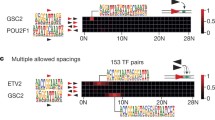Abstract
LHX3 is a LIM homeodomain transcription factor with established roles in pituitary and nervous system development. Mutations in the human LHX3 gene are associated with severe hormone deficiency diseases. Previous studies have shown that the human LHX3 gene produces at least three protein isoforms: LHX3a, LHX3b, and M2-LHX3. In gene activation assays, LHX3a and M2-LHX3 are significantly more active than LHX3b because the actions of LHX3b are repressed by an inhibitory domain in its amino terminus. In this report, we investigate the molecular characteristics that result in reduced transcriptional capacity of LHX3b by determining the optimal DNA binding preference of LHX3b. Site selection experiments using purified human LHX3b reveal that it selects AT-rich sequences that contain ATTA/TAAT motifs. The pool of sequences selected by LHX3b is similar to that selected by LHX3a but does not conform to as strict a consensus. Further, the LHX3b-selected sites are bound more avidly by LHX3a and M2-LHX3 suggesting that LHX3b does not act by recognizing LHX3b-specific binding sites in target genes. We conclude that the amino terminal repression domain of LHX3b mostly acts to reduce the transcriptional potency of LHX3 by inhibiting the DNA binding affinity of the homeodomain, with some reduction in DNA binding specificity.
Similar content being viewed by others
Abbreviations
- αGSU:
-
alpha glycoprotein subunit
- EMSA:
-
electrophoretic mobility shift assay
- FSH:
-
follicle-stimulating hormone
- GST:
-
glutathione-S-transferase
- LBC:
-
LHX3a binding consensus
- LHX3:
-
LIM homeobox gene 3
- LIM-HD:
-
LIM homeodomain
- PCR:
-
polymerase chain reaction
- PGBE:
-
pituitary glycoprotein basal element
- PRL:
-
prolactin
- SAAB:
-
selected and amplified binding site method
- TSH:
-
thyroid-stimulating hormone
References
JJ Savage BC Yaden P Kiratipranon SJ Rhodes (2003) Gene 319 1–19 Occurrence Handle1:CAS:528:DC%2BD3sXosFyjtrc%3D Occurrence Handle14597167
K Sharma HZ Sheng K Lettieri H Li A Karavanov S Potter H Westphal SL Pfaff (1998) Cell 95 817–828 Occurrence Handle1:CAS:528:DyaK1MXivVKg Occurrence Handle9865699
HZ Sheng K Moriyama T Yamashita H Li SS Potter KA Mahon H Westphal (1997) Science 278 1809–1812 Occurrence Handle1:CAS:528:DyaK2sXnvFCltbw%3D Occurrence Handle9388186
HZ Sheng AB Zhadanov B Mosinger SuffixJr T Fujii S Bertuzzi A Grinberg EJ Lee SP Huang KA Mahon H Westphal (1996) Science 272 1004–1007 Occurrence Handle1:CAS:528:DyaK28XjtVaqu7c%3D Occurrence Handle8638120
PW Howard RA Maurer (2001) J Biol. Chem. 276 19020–19026 Occurrence Handle1:CAS:528:DC%2BD3MXkt12ku70%3D Occurrence Handle11279219
I Netchine ML Sobrier H Krude D Schnabel M Maghnie E Marcos B Duriez V Cacheux A Moers M Goossens A Gruters S Amselem (2000) Nat. Genet. 25 182–186 Occurrence Handle1:CAS:528:DC%2BD3cXjvFOgtL4%3D Occurrence Handle10835633
KW Sloop GE Parker KR Hanna HA Wright SJ Rhodes (2001b) Gene 265 61–69 Occurrence Handle1:CAS:528:DC%2BD3MXhsleksLg%3D
KW Sloop CJ Dwyer SJ Rhodes (2001a) J. Biol. Chem. 276 36311–36319 Occurrence Handle1:CAS:528:DC%2BD3MXnt1yrsLc%3D
KW Sloop BC Meier JL Bridwell GE Parker AM Schiller S J Rhodes (1999) Mol Endocrinol 13 2212–2225 Occurrence Handle1:CAS:528:DyaK1MXnvVantLw%3D Occurrence Handle10598593
AB Zhadanov NG Copeland DJ Gilbert NA Jenkins H Westphal (1995) Genomics 27 27–32 Occurrence Handle1:CAS:528:DyaK2MXlvVahsro%3D Occurrence Handle7665181
I Bach SJ Rhodes RV Pearse Suffix2nd T Heinzel B Gloss KM Scully PE Sawchenko MG Rosenfeld (1995) Proc. Natl. Acad. Sci. USA 92 2720–2724 Occurrence Handle1:CAS:528:DyaK2MXksl2rsLc%3D Occurrence Handle7708713
BC Meier JR Price GE Parker JL Bridwell SJ Rhodes (1999) Mol. Cell Endocrinol. 147 65–74 Occurrence Handle1:CAS:528:DyaK1MXivVGltA%3D%3D Occurrence Handle10195693
I Bach (2000) Mech Dev 91 5–17 Occurrence Handle1:CAS:528:DC%2BD3cXhsVags7s%3D Occurrence Handle10704826
BE West GE Parker JJ Savage P. Kiratipranon KS Toomey LR Beach SC Colvin KW Sloop SJ Rhodes (2004) Endocrinology 145 4866–4879 Occurrence Handle1:CAS:528:DC%2BD2cXptVyht7Y%3D Occurrence Handle15271874
JA Bridwell JR Price GE Parker A McCutchan Schiller KW Sloop SJ Rhodes (2001) Gene 277 239–250 Occurrence Handle1:CAS:528:DC%2BD3MXnsFGgurg%3D Occurrence Handle11602361
TK Blackwell H Weintraub (1990) Science 250 1104–1110 Occurrence Handle1:CAS:528:DyaK3MXls1yqsg%3D%3D Occurrence Handle2174572
JP Thaler SK Lee LW Jurata GN Gill SL Pfaff (2002) Cell 110 237–249 Occurrence Handle1:CAS:528:DC%2BD38XlvV2htrg%3D Occurrence Handle12150931
GE Parker RM Sandoval HA Feister JP Bidwell SJ Rhodes (2000) J. Biol. Chem. 275 23891–23898 Occurrence Handle1:CAS:528:DC%2BD3cXls12lsrg%3D Occurrence Handle10818088
Parker GE, West B E, Witzmann FA & Rhodes SJ (2004) J. Cell. Biochem. In press.
Author information
Authors and Affiliations
Corresponding author
Rights and permissions
About this article
Cite this article
Yaden, B.C., Savage, J.J., Hunter, C.S. et al. DNA recognition properties of the LHX3b LIM homeodomain transcription factor. Mol Biol Rep 32, 1–6 (2005). https://doi.org/10.1007/s11033-004-4069-z
Accepted:
Issue Date:
DOI: https://doi.org/10.1007/s11033-004-4069-z




